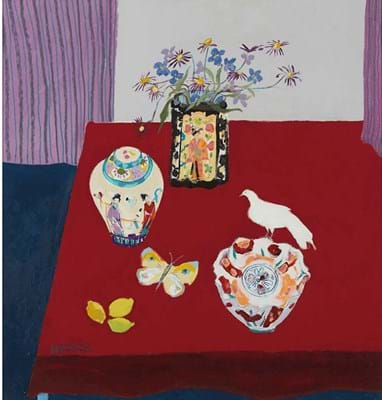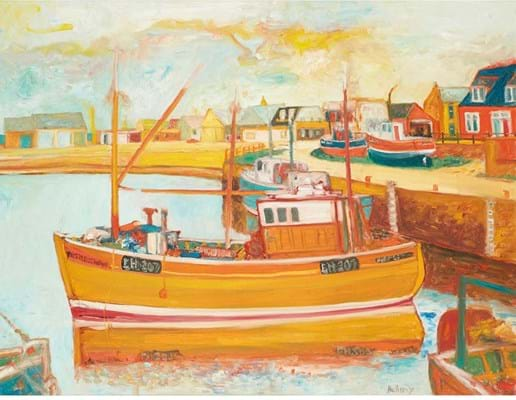
Two UK collecting societies and Dr Clare McAndrew’s Arts Economics have all compiled new data this summer shedding light on how much income is generated and who benefits from it.
ARR gives creators of original works across their lifetime, and for 70 years after their death, the right to a payment when their work is resold in the secondary market with the involvement of an art market professional. The rules, which came into force via an EU directive in 2006 updated in 2011 (see box, left), apply to works sold in the UK or another country in the European Economic Area (EEA) by an artist in the region.
The UK government argued against the law when it was first proposed and said it would damage UK competitiveness against countries where it is not law, such as in Asia and the US. But ARR would remain a UK law post-Brexit and is mentioned within the government’s Withdrawal Agreement.
Agencies that collect fees
Two agencies administer the collecting of the artists’ right fee in the UK: the Design and Artists Copyright Society (DACS) and the Artists’ Collecting Society (ACS).
When selling a work that qualifies for ARR, auction houses and dealers have responsibility to pay the correct amount and calculate the correct exchange rate at the time of sale (based on the exchange rate from the European Central Bank on the day of the sale).
Both agencies provide online calculators and checking guides on their websites to assist art market professionals on who to pay and how much. The auctioneer or dealer, who must check which is the relevant agency to pay, will have passed on the cost of this payment to the buyer (see box below).
Both ACS and DACS charge a 15% administration fee which is taken from the rights payments they receive. ACS claims its figures “help to dispel the myth that the bulk of all ARR royalties are paid to a small number of renowned artists’ estates”. It argues that any surplus income made from royalty payments is used for “the benefit of member artists and the artistic community”.
The art trade has largely been against ARR and continues to argue it is an unjust tax that disadvantages the UK and European art markets, over those in the US and Asia, and that it predominantly benefits wealthy artists’ estates.
In the 2014 Art Market report, author Dr McAndrew found “ARR has done nothing of significance to help artists on lower incomes or early in their careers, when they are in most need of financial support, even though they were its intended beneficiaries. It has been the heirs of recently died, highly sought after and well-known artists who have gained the most.”
Dr McAndrew is working on a forthcoming paper with Prof Victor Ginsburgh and new data to be included shows 54% of the total estimated ARR payout went to the estates of just 30 deceased artists in the UK in 2018, based on auction figures (see box below).
Art Economics 2018
(based on auction sales)
- 54% of the total estimated ARR payout went to the estates of just 30 deceased artists in the UK
- 73% of the total estimated ARR payout went to the top 50 artists in the UK
- 73% of this above figure (73%) was paid to heirs of deceased artists
Common misconception
Not everyone in the art market is in agreement about ARR, however.
Lawyer Rudy Capildeo at Charles Russell Speechlys acts for a number of artists and artists’ estates. He said: “Resale royalties are an incredibly important source of income for artists and their families. There is a common misconception, however, that this generally applies to blue-chip artists like Picasso and Hirst.
“The reality is that the royalties are often paid to all artists who have maintained a career and whose works still have a market today. A key issue for collecting societies is getting private dealers to cooperate so that artists and their heirs receive the royalties that are due to them, a matter made worse by the inherent confidentiality of art world transactions.
“Musicians, authors and filmmakers alike receive royalties. Artists too should be able to share in the benefits that their work brings to others.”
Artist’s Resale Right: details in brief
gov.uk/guidance/artists-resale-right
Royalties are paid on original works of art (including graphic works, paintings, sculptures, collages, ceramics and street art) when they are resold by an art market professional and the sale price exceeds €1000 (based on the exchange rate from the European Central Bank on the day of the sale). The amount due is calculated on a sliding scale according to the resale price of the artwork and is capped at €12,500.
- 4% between €1000-50,000
- 3% between €50,001-200,000
- 1% between €200,001-350,000
- 0.5% between €350,001-500,000
- 0.25% in excess of €500,000
This scale is also cumulative in much the same way as income tax is calculated. For example, the royalty payable for an art work sold for €200,000 would amount to €6500.
This is made up of:
- 1st tier to €50,000 will attract a royalty of 4% ie €2000
- 2nd tier €50,001 to €200,000 will attract a royalty of 3% ie €4500
VAT does not apply to the Artist’s Resale Right and resale royalties are calculated on the sale price excluding VAT and other fees.
The law is derived from a European Directive that came into force in the UK in 2006 and was later updated in The Artist’s Resale Right (Amendment) Regulations 2011 where it was extended to heirs or artists for 70 years after their death.
The artist does not have to be registered to a specific agency, the fee still applies.
Artists Collecting Society (ACS)
artistscollectingsociety.org.uk
- 48% or 2000 of the 4000-plus payments that ACS administered in 2017-18 were for artworks that sold for £3000 or less
- £12.3m in Artist’s Resale Right royalties distributed since June 2006
- £1.72m distributed to 445 members (artists or their estates) in 2017-18 financial year (on turnover of £2.18m at ACS)
- £94,200 re-invested into the artistic community in past three years
- 1342 mainly UK artists and artists’ estates represented
- 15% of each payment goes to ACS and any surplus income is “used for the benefit of our member artists and the artistic community”
Design and Artists Copyright Society (DACS)
- 53% of those who receive royalties are benefiting solely from the sale of artworks for £5000 or less (2018 figure)
- £78m distributed to artists by DACS since 2006
- £1.5m collected in previously unpaid royalties by DACS since 2014
- £18m paid in royalties to 58,000 artists and estates for payments for things including ARR and copyright licensing in 2018
- 100,000 artists and artists’ estates represented
- 15% of each payment goes to DACS which it says is “to cover the cost of our service”
What does this all mean for buyers?
The fee for Artist’s Resale Right or Droit de Suite applies in the European Economic Area to living artists and artists who have died in the last 70 years (currently artists who died after 1949).
Buyers of art should be aware that they will pay ARR via a charge by the auction house or dealer that will be passed onto the relevant collecting agency.
If buying at auction the additional ARR fee will be applicable on the hammer price if it reaches the threshold of €1000 (currently around £925).
If buying from a dealer the buyer should find out if the price quoted includes the fee.
However, there is an exception, known as the “bought as stock” exception, when no royalty is payable if the work in question was bought directly from the artist and then resold within three years for a value of €10,000 or less.
Buyers should also bear in mind that when acquiring an artwork that qualified for ARR the same work may not be subject to that fee when it is later sold on because it may be more than 70 years since the creator’s death.
















